Monmouth order of battle
The Battle of Monmouth on June 28, 1778 saw a colonial American army under Major General George Washington fight a British army led by Lieutenant General Sir Henry Clinton. After evacuating Philadelphia, Pennsylvania on June 18, Clinton intended to march his 13,000-man army to New York City. Washington sent 6,400 troops commanded by Major General Charles Lee to attack the British column of march near Monmouth Court House, New Jersey. When Clinton counterattacked, Lee ordered his badly deployed troops to fall back immediately. Washington brought up 7,000 men to support Lee's withdrawing wing and held his ground against repeated British assaults. That evening Clinton retreated from the field and continued his march to Sandy Hook, where the British fleet waited to ferry his army to New York. Both armies' casualties were about even in the last major battle in the northern colonies. Lee was court martialed for his behavior during the battle.[1]

British order of battle
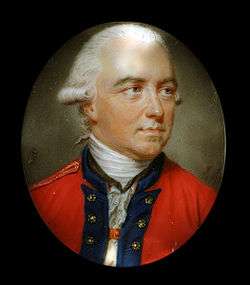
Lieutenant General Sir Henry Clinton (est. 18,000 - 19,000)[2]
- Staff:
- Adjutant General: Lieutenant Colonel Francis Lord Rawdon
- Deputy Adjutant General: Major Stephen Kemble, Captain George Hutchinson
- Assistant Adjutant General: Lieutenant James Cramond
- Quartermaster General: Brigadier General Sir William Erskine
- Royal Artillery Commander: Brigadier General James Pattison
- Senior Engineer Officer: Captain John Montresor (Absent)
- Aide-de-Camp: Major Duncan Drummond, Captains William Sutherland, Lord William Cathcart, William Crosbie, Alexander von Wilmowsky, Ernst von Munchhausen
- Military Secretary: Captain John Smith
- Deputy Inspector General of Provincial Forces: Captain Henry Rooke
- Deputy Muster-Master of Provincial Forces: Andrew Bell
1st Division
The 1st Division was commanded by Lieutenant General Lord Cornwallis and comprised 9,440 combat troops.[3]
| Unit | Commander | Strength | Notes |
|---|---|---|---|
| Rearguard | Brigadier General Sir William Erskine (Afternoon only) | ||
| Queen's American Rangers | Lieutenant Colonel John Graves Simcoe | 454 | British foot regiments each contained a company of light infantry, but during the American Revolutionary War these were detached to form the separate Light Infantry Battalion.[4] |
| 16th Queen's Light Dragoons | Lieutenant Colonel William Harcourt | 365 | |
| 1st Battalion Light Infantry | Lieutenant Colonel Robert Abercromby | 730 | |
| Grenadiers | |||
| 1st Battalion | Lieutenant Colonel William Meadows | 761 | British foot regiments each contained a company of Grenadiers, but during the American Revolutionary War these were detached to form separate Grenadier battalions.[4] |
| 2nd Battalion | Lieutenant Colonel Henry Monckton | 737 | |
| Guards | Brigadier General Edward Mathew | ||
| 1st Battalion | Colonel Henry Trelawny | 502 | The Guards battalions were formed for service in North America by drawing fifteen men from each of the sixty-four Guards companies of the Foot Guard regiments.[5] |
| 2nd Battalion | Lieutenant Colonel Thomas Howard | 480 | |
| 3rd Brigade | Major General Charles Grey | ||
| 15th Regiment of Foot | Lieutenant Colonel Joseph Stopford(?) | 352 | |
| 17th Regiment of Foot | Lieutenant Colonel Charles Mawhood | 330 | |
| 42nd (Royal Highland) Regiment of Foot | Lieutenant Colonel Thomas Stirling | 639 | |
| 44th Regiment of Foot | Lieutenant Colonel Henry Hope | 334 | |
| 4th Brigade | Major General Charles Grey | ||
| 33rd Regiment of Foot | Lieutenant Colonel James Webster | 365 | |
| 37th Regiment of Foot | Major James Cousseau | 386 | |
| 46th Regiment of Foot | Lieutenant Colonel Enoch Markham | 319 | |
| 64th Regiment of Foot | Major Robert McLeroth | 426 | |
| 5th Brigade | Brigadier General Alexander Leslie | ||
| 7th Regiment of Foot (Royal Fusiliers) | Lieutenant Colonel Alured Clarke | 333 | |
| 26th Regiment of Foot | Lieutenant Colonel Charles Stuart | 314 | |
| 63rd Regiment of Foot | Colonel James Paterson(?) | 305 | |
| Hessian Grenadiers | Colonel Heinrich Julius von Kospoth | ||
| Linsing | Lieutenant Colonel Otto Christian von Linsing | 411 | |
| Minnigerode | Lieutenant Colonel Friedrich L. von Minnigerode | 427 | |
| Lengerke | Lieutenant Colonel Georg Emanuel Lengerke | 453 | |
| Noncombatants | |||
| Women | 355 | Number of women granted permission to accompany the army. Because many women who were supposed to have been transported from Philadelphia by sea chose to accompany the army overland, the actual number was greater.[6] | |
Artillery
The artillery was divided between the two divisions.[7]
| Unit | Commander | Strength | Notes |
|---|---|---|---|
| Artillery | Brigadier General James Pattison | ||
| Royal Artillery | 634 | The British employed a mix of howitzers and 1.5-, 3-, 6-, 12- and 24-pounder guns.[8] The New Jersey Volunteers comprised four companies of matrosses.[9] | |
| Drivers | 261 | ||
| 2nd Battalion, New Jersey Volunteers | 129 | ||
| Hessian Artillery | 39 | ||
| Anspach Artillery | 34 | ||
| Noncombatants | |||
| Women | 34 | Number of women granted permission to accompany the army. Because many women who were supposed to have been transported from Philadelphia by sea chose to accompany the army overland, the actual number was greater.[6] | |
| Children | 3 | ||
2nd Division
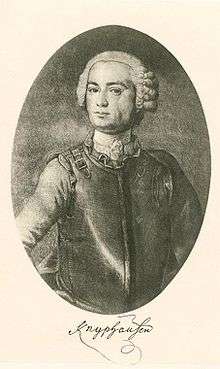
The 2nd Division was commanded by Lieutenant General Wilhelm von Knyphausen and comprised 8,229 combat troops and 1,394 noncombatants.[10] While the 1st Division fought at Monmouth Court House, the 2nd Division proceeded with the 1,500 wagons of the baggage train towards Middletown. It endured only light harassment from American militia along the way.[11]
| Unit | Commander | Strength | Notes |
|---|---|---|---|
| 17th Light Dragoons | Lieutenant Colonel Samuel Birch | 333 | British foot regiments each contained a company of light infantry, but during the American Revolutionary War these were detached to form the separate Light Infantry Battalion.[4] |
| 2nd Battalion Light Infantry | Lieutenant Colonel John Maitland | 799 | |
| Jäger Korps | Lieutenant Colonel Ludwig von Wurmb | ||
| Hessian Jägers | 701 | Of the Hessian Jägers, 37 were mounted and 664 were infantry.[12] | |
| Anspach Chasseurs | 92 | ||
| 1st Brigade | Major General James Grant | ||
| 4th (King's Own) Regiment of Foot | Lieutenant Colonel James Ogilvie | 321 | |
| 23rd Regiment of Foot (Royal Welsh Fusiliers): | Lieutenant Colonel Nesbitt Balfour | 432 | |
| 28th Regiment of Foot: | Lieutenant Colonel Robert Prescott | 313 | |
| 49th Regiment of Foot: | Lieutenant Colonel Sir Henry Calder | 372 | |
| 2nd Brigade | Major General James Grant | ||
| 5th Regiment of Foot | Major George Harris(?) | 367 | |
| 10th Regiment of Foot | Lieutenant Colonel Francis Smith | 135 | |
| 27th (Inniskilling) Regiment of Foot | Lieutenant Colonel Edward Mitchell | 340 | |
| 40th Regiment of Foot | Lieutenant Colonel Sir Thomas Musgrave | 322 | |
| 55th Regiment of Foot | Lieutenant Colonel Cornelius Cuyler | 268 | |
| Stirn's Brigade | Major General Johann Daniel Stirn | ||
| Leib Infantry Regiment | Colonel Friedrich W. von Wurmb | 573 | |
| Infantry-Regiment von Donop | Colonel David von Gosen | 580 | |
| Loos's Brigade | Colonel Johann August von Loos | ||
| Fusilier Regiment von Alt Lossberg | Colonel Johann August von Loos | 276 | Grenadier Regiment von Woellworth was distributed between the two Fusilier regiments.[13] |
| Fusilier Regiment von Knyphausen | Major Johann Friedrich von Stein | 253 | |
| Grenadier Regiment von Woellworth | 257 | ||
| Provincial Infantry | |||
| Guides and pioneers | Captain Simon Fraser | 206 | |
| Roman Catholic Volunteers | Lieutenant Colonel Alfred Clifton | 207 | |
| Maryland Loyalists | Lieutenant Colonel James Chambers | 370 | |
| Pennsylvania Loyalists | Lieutenant Colonel William Allen | 168 | |
| New Jersey Volunteers | Lieutenant Colonel John Van Dyke | 211 | |
| Bucks County Volunteers | Captain William Thomas | 76 | |
| Provincial Horse | |||
| Philadelphia Light Dragoons | Captain Richard Hovenden | 116 | |
| Bucks County Light Dragoons | Lieutenant Walter Willet | 60 | |
| Provincial Recruits | |||
| 3rd Battalion of New Jersey Volunteers | 17 | ||
| Caledonian Volunteers | Captain William Sutherland | 9 | |
| Volunteers of Ireland | Lieutenant Colonel Francis Lord Rawdon | 16 | |
| Emmericks Chasseurs | Captain Christian Huck | 11 | |
| Noncombatants | |||
| Black pioneers | Captain Allen Stewart | 49 | The quantity shown for women represents the official figure of those granted permission to accompany the army. Because many women who were supposed to have been transported from Philadelphia by sea chose to accompany the army overland, the actual number was greater.[6] |
| Paymaster's guard and suite | 10 | ||
| Lieutenant Colonel Rawdon's guard and suite | 3 | ||
| Deputy Inspector General of Provincial Forces | Captain Henry Rooke | 3 | |
| Quartermaster General Department | Sir William Erskine | 494 | |
| Engineer's Department | 138 | ||
| Bridgemaster's Department | 21 | ||
| Royal Artillery Company of Conductors and Artificers | 51 | ||
| Surgeons etc. | 19 | ||
| Sick and attendants of general hospital | 134 | ||
| Provost Martial, guard, prisoners and criminals | 57 | ||
| Refugees | 91 | ||
| Women | 318 | ||
| Children | 6 | ||
American order of battle
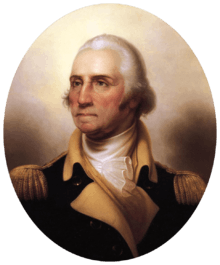
General George Washington (est. 15,000 - 16,000)[14]
{Curly Brackets indicate Brigade/Regimental/Battalion Strength}
- Staff:
- Quartermaster General: Major General Nathanael Greene
- Inspector General: Major General: Friedrich Wilhelm von Steuben
- Senior Artillery Officer: Brigadier General Henry Knox
- Senior Engineer Officer: Brigadier General Louis Lebègue Duportail
- Adjutant General: Colonel Alexander Scammell
- Commissary Generals: Colonels Jeremiah Wadsworth and Clement Biddle
- Judge Advocate General: Colonel John Lawrence
- Military Secretary: Lieutenant Colonel Robert H. Harrison
- Assistant Secretary: James McHenry
- Aide-de-Camp: Lieutenant Colonels John Fitzgerald, Alexander Hamilton, John Laurens and Richard Meade
- Volunteer Aides-de-Camp: Brigadier Generals Joseph Reed and John Cadwalader
Vanguard
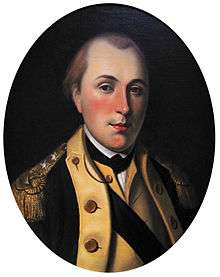
The vanguard was commanded by Major General Charles Lee and comprised approximately 4,540 troops.[15]
- Staff:
- Acting Adjutant General: Lieutenant Colonel John Brooks
- Aide-de-camp: Captains John Francis Mercer and Evan Edwards
- Senior Artillery Officer: Lieutenant Colonel Eleazer Oswald
- Deputy Inspector: Jean Baptiste Ternant
- Advisers: Brigadier General David Forman and Colonel Marquis François de Malmedy
| Unit | Commander | Strength | Notes |
|---|---|---|---|
| Scott's Brigade | Colonel William Grayson | 600 | |
| Combined 4th, 8th and 12th Virginia Regiments* | Colonel William Grayson | ||
| Grayson's and Patton's Additional Continental Regiments | Lieutenant Colonel John Parke | ||
| Company, Crane's Artillery Regiment | Captain Thomas Wells | 2 guns | |
| Varnum's Brigade | Colonel John Durkee | 300–350 | |
| Combined 4th and 8th Connecticut Regiments | Colonel John Durkee | ||
| Combined 1st and 2nd Rhode Island Regiments | Lieutenant Colonel Jeremeiah Olney | ||
| Company, Crane's Artillery Regiment | Captain David Cook | 2 guns | |
| Wayne's Detachment | Brigadier General Anthony Wayne* | 1,000 | Commanded by Major General the Marquis de Lafayette during the morning attack on the British rearguard. |
| Livingston's Battalion | Colonel Henry Beekman Livingston | Picked men (elite, ad hoc light infantry battalions formed by taking the best troops from across all regiments).[16] | |
| Stewart's Battalion | Colonel Walter Stewart | ||
| Wesson's Battalion | Colonel James Wesson | ||
| Company, Crane's Artillery Regiment | Captain Thomas Seward | 2 guns | |
| Scott's Detachment | Brigadier General Charles Scott | 1,440 | |
| Cilley's Battalion | Colonel Joseph Cilley | Picked men | |
| Parker's Battalion | Colonel Richard Parker | ||
| Butler's Battalion* | Colonel Richard Butler | ||
| Gist's Battalion | Colonel Mordecai Gist | ||
| Artillery | 4 guns | Unit not known | |
| Jackson's Detachment* | Colonel Henry Jackson | 200–300 | |
| Jackson's Additional Continental Regiment | Colonel Henry Jackson | ||
| Henley's Additional Continental Regiment | Unknown | ||
| Lee's Additional Continental Regiment | Unknown | ||
| New Jersey Brigade | Brigadier General William Maxwell | 1,000 | |
| 1st New Jersey Regiment | Colonel Matthias Ogden | ||
| 2nd New Jersey Regiment | Colonel Israel Shreve | ||
| 3rd New Jersey Regiment | Colonel Elias Dayton | ||
| 4th New Jersey Regiment | Lieutenant Colonel David Brearley | ||
| Independent artillery company | Captain Thomas Randall | 2 guns | |
| New Jersey Militia Light Horse | Lieutenant Colonel Anthony Walton White | ||
| Somerset County Light Horse | Captain John Stryker | ||
| Middlesex County Light Horse | Captain Robert Nixon | ||
* Lee reshuffled his troops before launching his attack on the British rearguard, and put Wayne in charge of a detachment comprising Grayson's combined Virginia regiments, Butler's battalion and Jackson's detachment. Lafayette took over command of Wayne's original detachment.[17][18]
Other advanced forces
| Unit | Commander | Strength | Notes |
|---|---|---|---|
| New Jersey and Pennsylvania Militia | Major General Philemon Dickinson | 1,200+[19] | |
| Hunterdon Light Horse | Captain Israel Carle | Operating from Tennent's Meeting House | |
| 1st Burlington | Colonel William Shreve | ||
| 1st Cumberland | Lieutenant Colonel Samuel Ogden | ||
| 2nd Cumberland | Major Thomas Ewing | ||
| 1st Essex | Colonel Samuel Potter | ||
| 2nd Essex | Colonel Philip Van Courtland | ||
| Hunterdon Artillery (as infantry) | Captain Joseph Clunn | ||
| 1st Hunterdon | Colonel Joseph Philips | ||
| 2nd Hunterdon | Colonel Joseph Beavers | ||
| 3rd Hunterdon | Colonel David Chambers | ||
| 4th Hunterdon | Colonel John Taylor | ||
| 3rd Middlesex | Colonel Jacob Hyer | ||
| 1st Salem | Colonel Samuel Dick | ||
| 1st Somerset | Colonel Frederick Frelinghuysen | ||
| 2nd Somerset | Hendrick Van Dyke | ||
| Pennsylvania Volunteers | Brigadier General John Cadwalader | ||
| Eastern Morris and other militia | Colonel Sylvanus Seely | Operating from Foreman's Mill | |
| 1st Middlesex | Colonel John Webster | Operating from the vicinity of Scots Meeting House and Van Doren's Mill | |
| 2nd Middlesex | Colonel John Neilson | ||
| 3rd Monmouth | Colonel Daniel Hendrickson | ||
| Rifle and light infantry detachment | Colonel Daniel Morgan | 824 | Because of a series of miscommunications, Morgan remained at Richmond Mills, some two miles (three kilometres) to the south of Monmouth Court House, and did not participate in the battle.[20] |
| Various | Rifle companies detached from the 1st, 4th and 12th Pennsylvania Regiments, and from the 6th, 7th, 8th and 11th Virginia Regiments Light infantry companies detached from the 1st and 2nd North Carolina Regiments | ||
| 1st Monmouth | Colonel Asher Holmes | New Jersey Militia | |
| 2nd Monmouth | Colonel Samuel Forman | ||
| 2nd Burlington | Lieutenant Colonel Joseph Haight | ||
| Monmouth County Artillery | Captain Joshua Huddy | ||
| Dragoon detachment | Colonel Stephen Moylan | Harassed the British 2nd Division as it marched towards Middletown | |
| Detachments of the 1st, 3rd and 4th Light Dragoons | |||
| Source: Lender & Stone pp. 453–455 | |||
Main line of defenses
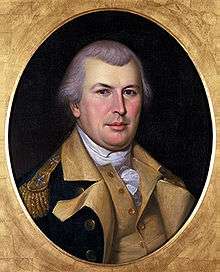
| Unit | Commander | Strength | Notes |
|---|---|---|---|
| Learned's Brigade | Colonel John Bailey (probable) | 373 | |
| 2nd Massachusetts Regiment | Colonel John Bailey | ||
| 8th Massachusetts Regiment | Colonel Michael Jackson | ||
| 9th Massachusetts Regiment | Colonel James Wesson* | ||
| Glover's Brigade | Unknown | 636 | |
| 1st Massachusetts Regiment | Colonel Joseph Vose | ||
| 4th Massachusetts Regiment | Colonel William Shepard | ||
| 13th Massachusetts Regiment | Colonel Edward Wigglesworth | ||
| 15th Massachusetts Regiment | Colonel Timothy Bigelow | ||
| Huntington's Brigade | Brigadier General Jedediah Huntington | 632 | |
| 1st and 7th Connecticut Regiments | Colonel Hernan Swift | ||
| 2nd and 5th Connecticut Regiments | Colonel Philip Burr Bradley | ||
| Poor's Brigade | Brigadier General Enoch Poor | 754 | |
| 1st New Hampshire Regiment | Colonel Joseph Cilley* | ||
| 2nd New Hampshire Regiment | Colonel Nathan Hale | ||
| 3rd New Hampshire Regiment | Lieutenant Colonel Henry Dearborn* | ||
| 2nd New York Regiment | Colonel Philip Van Cortlandt | ||
| 4th New York Regiment | Colonel Henry Beekman Livingston* | ||
| Artillery | Brigadier General Henry Knox | 10–12 guns | |
| * Detached from their regiments to lead detachments of picked men. | |||
| Source: Lender & Stone 2016 pp. 457–458 | |||
Forward screen
| Unit | Commander | Strength | Notes |
|---|---|---|---|
| Scott's detachment (partial) | Brigadier General Charles Scott | c.720 | |
| Cilley's Battalion | Colonel Joseph Cilley | Picked men | |
| Parker's Battalion | Colonel Richard Parker | ||
| 1st Pennsylvania Brigade | Brigadier General Anthony Wayne* | 429 | Colonel William Irvine took over in Wayne's absence |
| 1st Pennsylvania Regiment | Colonel James Chambers | ||
| 2nd Pennsylvania Regiment | Colonel Henry Bicker | ||
| 7th Pennsylvania Regiment | Colonel William Irvine | ||
| 10th Pennsylvania Regiment | Colonel George Nagel | ||
| 2nd Pennsylvania Brigade | Unknown | 487 | |
| 1st New York Regiment | Colonel Goose Van Schaick | ||
| 4th Pennsylvania Regiment | Lieutenant Colonel William Butler* | ||
| 5th Pennsylvania Regiment | Colonel Francis Johnston | ||
| 11th Pennsylvania Regiment | Colonel Richard Humpton(?) | ||
| 3rd Pennsylvania Brigade | Colonel Oliver Spencer (probable) | 438 | |
| 3rd Pennsylvania Regiment | Colonel Thomas Craig | ||
| 6th Pennsylvania Regiment | Lieutenant Colonel Josiah Harmar | ||
| 9th Pennsylvania Regiment | Colonel Richard Butler* | ||
| 12th Pennsylvania Regiment | Unknown | ||
| Malcolm's Additional Continental Regiment | Lieutenant Colonel Aaron Burr | ||
| Spencer's Additional Continental Regiment | Colonel Oliver Spencer | ||
| * Detached from their regiments to lead detachments of picked men. | |||
| Source: Lender & Stone 2016 pp. 456–457 | |||
Reserve (Perrine's Hill)
Forces commanded by Lafayette shadowed the British flanking column then rested behind the main defensive line at Perrine's Hill.[21]
| Unit | Commander | Strength | Notes |
|---|---|---|---|
| North Carolina Brigade | Colonel Thomas Clark | 425 | |
| 1st North Carolina Regiment | Colonel Thomas Clark | ||
| 2nd North Carolina Regiment | Colonel John Patten | ||
| 1st Maryland Brigade | Brigadier General William Smallwood | 790 | |
| 1st Maryland Regiment | Colonel John Hoskins Stone | ||
| 3rd Maryland Regiment | Colonel Mordecai Gist* | ||
| 5th Maryland Regiment | Colonel William Richardson | ||
| 7th Maryland Regiment | Colonel John Gunby | ||
| 1st Delaware Regiment | Colonel David Hall | ||
| New Jersey Brigade (partial) | Unknown | c.500 | |
| 2nd New Jersey Regiment | Colonel Israel Shreve | ||
| 1st New Jersey Regiment | Colonel Matthias Ogden | ||
| Source: Lender & Stone 2016 p. 458 | |||
Combs Hill
When the main body reached Tennent's Meeting House, some two miles (three kilometres) east of Englishtown, Washington ordered Major General Nathanael Greene to take a brigade to cover the right flank. Greene was guided to Combs Hill by Lieutenant Colonel David Rhea of the 2nd New Jersey Militia.[22]
| Unit | Commander | Strength | Notes |
|---|---|---|---|
| Woodford's Brigade | Brigadier General William Woodford | 475 | |
| 3rd and 7th Virginia Regiments | Lieutenant Colonel Holt Richardson | ||
| 11th and 15th Virginia Regiments | Lieutenant Colonel John Cropper | ||
| Artillery | Lieutenant Colonel chevalier du Plessis-Mauduit | 4 guns | |
| Source: Lender & Stone 2016 p. 459 | |||
Reserve (Englishtown)
Washington sent four brigades under Major General Friedrich Wilhelm von Steuben back to Englishtown to form a reserve.[23]
| Unit | Commander | Strength | Notes |
|---|---|---|---|
| Paterson's Brigade | Brigadier General John Paterson | 485 | |
| 10th Massachusetts Regiment | Colonel Thomas Marshall | ||
| 11th Massachusetts Regiment | Colonel Benjamin Tupper | ||
| 12th Massachusetts Regiment | Colonel Samuel Brewer | ||
| 14th Massachusetts Regiment | Colonel Gamaliel Bradford | ||
| 2nd Maryland Brigade | Unknown | 602 | |
| 2nd Maryland Regiment | Lieutenant Colonel Thomas Woolford | ||
| 4th Maryland Regiment | Colonel Josias Carvil Hall | ||
| 6th Maryland Regiment | Colonel Otho Holland Williams | ||
| Muhlenberg's Brigade | Brigadier General Peter Muhlenberg | 711 | |
| 1st, 5th and 9th Virginia Regiments | Colonel Richard Parker* | ||
| 1st Virginia State Regiment | Colonel George Gibson | ||
| 2nd Virginia State Regiment | Colonel Gregory Smith | ||
| German Battalion | Lieutenant Colonel Ludowick Weltner | ||
| Weeden's Brigade | Brigadier General George Weeden | 587 | |
| 2nd Virginia Regiment | Colonel Christian Febiger | ||
| 6th Virginia Regiment | Colonel John Gibson | ||
| 10th Virginia Regiment | Colonel John Green | ||
| 14th Virginia Regiment | Colonel William Davies | ||
| * Detached from regiment to lead a detachment of picked men. | |||
| Source: Lender & Stone 2016 pp. 460–461 | |||
Notes
- Footnotes
- Citations
- Eggenberger, 282
- Johnson, 95. Johnson listed the British total strength and the organization down to brigade and detachment level.
- Lender & Stone 2016 pp. 468–470
- Lender & Stone 2016 pp. 48, 49
- Lender & Stone 2016 p. 48
- Lender & Stone 2016 p. 548
- Lender & Stone 2016 pp. 467–468
- Lender & Stone 2016 p. 54
- Lender & Stone 2016 p. 468
- Lender & Stone 2016 pp. 463–467
- Lender & Stone 2016 pp. 97–98, 350–352
- Lender & Stone 2016 p. 463
- Lender & Stone 2016 p. 465
- Morrissey (2008), 86
- Lender & Stone 2016 pp. 451–453
- Bilby & Jenkins 2010 pp. 26, 128
- Bilby & Jenkins 2010 pp. 186, 195
- Lender & Stone 2016 p. 253
- Lender & Stone p. 234
- Lender & Stone 2016 pp. 185, 194, 234–236
- Lender & Stone 2016 p. 458
- Lender & Stone 2016 pp. 284, 333
- Lender & Stone 2016 pp. 315–317
References
- Bilby, Joseph G.; Jenkins, Katherine Bilby (2010). Monmouth Court House: The Battle That Made the American Army. Yardley, Pennsylvania: Westholme Publishing. ISBN 978-1-59416-108-7.
- Eggenberger, David (1985). An Encyclopedia of Battles. New York: Dover Publications. ISBN 0-486-24913-1.CS1 maint: ref=harv (link)
- Heitman, Francis Bernard (1914). Historical Register of Officers of the Continental Army during the War of the Revolution. Washington, D.C.: Rare Book Shop Publishing Company.CS1 maint: ref=harv (link)
- Johnson, Curt (1975). Battles of the American Revolution. London: Rand McNally & Company. ISBN 0-528-81022-7.CS1 maint: ref=harv (link)
- Lender, Mark Edward; Stone, Garry Wheeler (2016). Fatal Sunday: George Washington, the Monmouth Campaign, and the Politics of Battle. Norman, Oklahoma: University of Oklahoma Press. ISBN 978-0-8061-5335-3.
- Martin, David G., Millman, Leonard, Smith, Eric Lee. Battle of Monmouth: The Colonies take the Offensive war game. New York, NY: Simulations Publications, Inc., 1982.
- Morrissey, Brendan (2008). Monmouth Courthouse 1778: The last great battle in the North. Long Island City, N.Y.: Osprey Publishing. ISBN 978-1-84176-772-7.CS1 maint: ref=harv (link)
- McGuire, Thomas J. (2006). The Philadelphia Campaign, Volume I. Mechanicsburg, Penn.: Stackpole Books. ISBN 0-8117-0178-6.CS1 maint: ref=harv (link)
- McGuire, Thomas J. (2007). The Philadelphia Campaign, Volume II. Mechanicsburg, Penn.: Stackpole Books. ISBN 0-8117-0206-5.CS1 maint: ref=harv (link)
- revolutionarywar101.com American Revolutionary War Units
- ushistory.org Regiments at Valley Forge